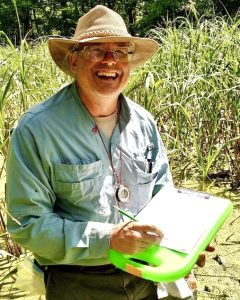
Mark Krivchenia earned an MS in Natural Resources and Environmental Science from the University of Illinois at Urbana Champaign. After retiring from a professional career with the University of Illinois at Chicago, he moved to Marietta to pursue his passion for the science and practice of ecological restoration. Mark currently serves as Steward of the Broughton Nature Preserve, President of Friends of the Ohio River Islands National Wildlife Refuge, and is a Board Member of the Society of Ecological Restoration, Midwest Great Lakes Chapter. He is an active member in the Society for Ecological Restoration (SER).
Faith in a Seed
September 9, 2023
“I have great faith in a seed. Convince me that you have a seed there, and I am prepared to expect wonders.” Henry David Thoreau.
One of the pillars of restoration ecology is the collection and dissemination of native seeds. Among midwestern prairie restorationists, it is a late summer and fall ritual to collect native seeds and sow them into prepared prairie restoration sites. If you have funds, you can buy native seed mixes. But these often lack rare, high quality species—they are difficult to both find and collect.
Here in Southeastern Ohio, this is not a common practice. Folks will often offer me native plants dug from their garden—but this strikes me as impractical for larger scale restoration projects.
At the Broughton Nature Preserve, last year volunteers collected over seventy species of native plants. After processing them into seed mixes, we had over 17 pounds of native seeds to sow—that is millions of seeds, worth hundreds of dollars. In the winter, we went out, raked the ground, and sowed the seeds in hopes of helping native plants get a foothold in the areas we had cleared of invasive plants.
You might wonder: why bother collecting native seeds? Shouldn’t you let nature do this work on its own?
The are some good reasons to collect seeds.
First, when we remove invasive plants from the landscape, we are opening the ground to more sunlight and a chance for new plant growth. Unfortunately, this is exactly what invasive plants are best at—taking advantage of disturbance in the ecosystem. If we don’t seed native plants in the newly cleared soil, most likely what comes up will be more invasive weeds.
One of the main tenets of restoration is that you usually can’t just remove invasive plants and hope for the best. You need to help native plants get a foothold by seeding.
Second, many of the native plants are simply gone from the landscape. They have been lost due to agriculture or grazing, or lumbering. The insects or birds that help to pollinate and spread these plants aren’t there anymore either. So, the only way to restore these native plants is to give them some help. Seems fair—human activity removed them; to re-establish a native ecosystem, humans can aid in that recovery.
It is too early to tell how successful this process will be. Native plants often take years to establish and show themselves as flowering plants. But there are decades of experience across the world that have shown this to be successful. We just have to figure out the right species to collect, and the best way to increase successful growing here is Southeastern Ohio.
